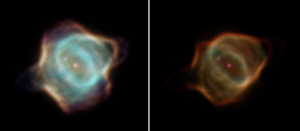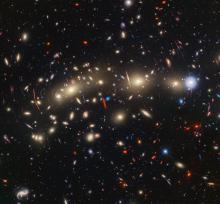Images from Hubble Space Telescope taken two decades apart show dramatic changes in the Stingray Nebula, the last gasp of a dying star. The star, which is visible at the center of the nebula, has expelled its outer layers into space, forming the nebula. In the image at left, taken in 1996, the nebula shines brightly, with regions of blue and green at its center. In the image at right, taken in 2016, the nebula has faded considerably. The change probably was caused by changes in the dying star. As seen in 1996, it probably was entering a new round of nuclear reactions that caused it to flare up, brightly illuminating the surrounding nebula. By 2016, that outburst had ended, and the star wasn't bright enough to energize the nebula to the same extent. The nebula is still there and still expanding into space, but with a fainter light at its center, we can't see the full extend of the Stingray. [NASA/ESA/B. Balick (Univ. Washington)/M. Guerrero (Inst. de Astrofísica de Andalucía)/G. Ramos-Larios (Univ. de Guadalajara)]
You are here
Stingray Nebula
A cosmic “stingray” is fading away before our eyes. A recent study found that it grew much fainter and cooler in just a couple of decades — and even lost its shape.
The Stingray Nebula is about 18,000 light-years away. It’s in the constellation Ara, which is too far south to see from most of the U.S.
The nebula is the final gasp of a dying star. The star expelled its outer layers into space, forming a rapidly expanding “bubble” of gas and dust.
The Stingray is the youngest such nebula yet seen. It began forming just a few decades ago. And in 1996, an image from Hubble Space Telescope showed a bright and colorful bubble whose outline resembled that of a stingray.
But a recent study compared that picture to one taken 20 years later. And in the more recent observation, the Stingray was only a fraction as bright. It didn’t look nearly as big, and a blue-green glow at its center had vanished.
The change probably was caused by the star’s dying core. A few decades ago, a shell of helium around the core probably ignited, causing the core to flare up. The extra energy shined on the surrounding gas and dust, causing it to glow like a neon bulb.
In the more recent image, though, the flare-up had ended, and the core had grown cooler and fainter. So there wasn’t enough energy to light up the entire nebula. The nebula is still there, expanding rapidly into space. But we just can’t see the full outline of the Stingray.
Script by Damond Benningfield
Get Premium Audio
Listen to today's episode of StarDate on the web the same day it airs in high-quality streaming audio without any extra ads or announcements. Choose a $8 one-month pass, or listen every day for a year for just $30.







